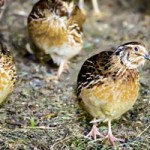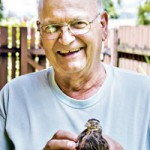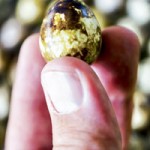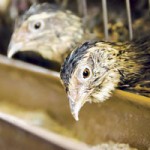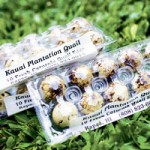Farm-fresh Quail Eggs On Kaua‘i
Willie Ornellas raises about 150 Japanese quail hens and harvests about 100 eggs each day. He and his partner Helen Strama sell 10 eggs for $3 Wednesdays in Esaki’s Produce parking lot.
In the ’80s, Ornellas was the owner of a construction company in California. As a hobby, he began raising quail to train his hunting dogs, and sold excess meat and eggs to restaurants. The Kaua‘i native returned in 1992 to help his family after Hurricane Iniki.
QUAIL EGGS
The Japanese quail is closely related to the common quail, and ranges from Western Europe across Eurasia to Mongolia and Japan. Apparently, they were domesticated in Asia by the 12th century, and bred initially for the enjoyment of their song, then later for eggs and meat.
Quail eggs are considered a delicacy in many countries, including Western Europe and North America. In Japanese cuisine, they are sometimes used raw or cooked as tamago in sushi, and often found in bento lunches.
Season: A baby quail hatches from the egg 17 days after it’s laid. It reaches full maturity in 50 days, and will produce 250 eggs in its lifetime. Quail lay eggs year-round.
What to look for: Japanese quail eggs are varied in their color patterns. They range from snow white to completely brown. More commonly they are tan and dark brown speckled or mottled brown with a chalky blue covering. Each hen lays eggs with a characteristic shell pattern or color.
Storage: Unwashed farm-fresh eggs store a lot longer than washed ones. They are naturally coated with a light layer of “bloom.” When this natural protective coating is removed, it leaves the eggs subject to aging and bacteria.
For appearances, most eggs are washed and will store, refrigerated, for about one month. Eggs can remain edible for even longer, but freshness (egg yolk that sits firm and high, and a thick, viscous egg white) will be noticeably less after two weeks.
Preparation: For hardboiled eggs, gently spoon eggs in boiling water and cook for 10 minutes. The mottled colors do not change, so these make unique Easter eggs.
Hard-boiled quail eggs are just like bite-sized chicken eggs. They make delicious appetizers, snacks or can be used to dress up salads, saimin and soups. They can be pickled by adding hot vinegar, salt and pepper, and ingredients such as herbs, ginger, garlic, onions, chili peppers, and cooked bacon or sausage.
Tip: Quail eggs have a harder shell and thicker membrane than chicken eggs, which makes them difficult to clean. Ornellas taps the wide end, where the air pocket is, on the counter to crack. He removes the cap, and soaks them in water for five minutes. This loosens the shell from the membrane. Then he runs a sharp knife along the inside, prying the shell and membrane away from the egg. He can clean 1,000 eggs in two hours.
Health benefits: One quail egg weighs 9 grams (a large chicken egg weighs 33 grams). Twenty-eight grams of raw quail eggs contains 44 calories, 3 grams of fat, 236 milligrams of cholesterol, 4 grams of protein, 3 percent DV of vitamin A, 2 percent calcium, and 6 percent iron. They are a good source of folate, vitamin B12, pantothenic acid, iron and phosphorus, and a very good source of protein, riboflavin and selenium.
In comparison, 28 grams of raw chicken eggs contains 40 calories, 3 grams of fat, 118 milligrams cholesterol, 4 grams of protein, 3 percent DV of vitamin A, 1 percent calcium, and 3 percent iron. They are a good source of riboflavin, vitamin B12 and phosphorus, and a very good source of protein and selenium.
Kaua‘i Plantation Quail Eggs can be found at: Esaki’s Produce parking lot Wednesdays (3 to 4 p.m). Esaki’s Produce also distributes quail eggs to local restaurants and retail outlets such as Kaua‘i Marriott Resort, Kintaro Japanese Restaurant, and TJ Variety in Hanamaulu. For more information, call 823-6014.
TORO TEI’S QUAIL EGG TOBIKO
Guy Higa, executive chef at Kaua‘i Marriott Resort, contributed this recipe, which is on the menu at Toro Tei. The raw eggs rest on two bundles of sushi rice wrapped in nori and are topped with a thick layer of tobiko.
2 quail egg yolks
1 ounce tobiko, ikura flying fish or salmon caviar
1 ounce prepared sushi rice
2 1-by-5-inch nori strips
1 dab wasabi paste
1/2 teaspoon minced baby chives
Form rice into two oval balls and smear a little wasabi on top. Wrap nori around rice to form a battleship-style roll. Fill the top with caviar.
Crack an egg in your hand and remove most of the white. Place yolk on top of caviar and garnish with minced baby chives. Serve with shoyu.
Marta Lane is a freelance food writer. For more information, visit TastingKauai.com.
- Quail hens have white on their chest, males don’t
- Willie Ornellas
- A quail egg weighs 9 grams. Daniel Lane photos
- Adult Japanese quail eat from 14 to 18 grams of food a day
- Ten quail eggs sell for $3. Daniel Lane photos

